
Vrlika is a small town in inland Split-Dalmatia County, Croatia. The closest large towns are Sinj, Knin, and Drniš. Vrlika was given the status of town in 1997. Vrlika is an underdeveloped municipality which is statistically classified as the First Category Area of Special State Concern by the Government of Croatia.

The Pre-Romanesque period in European art spans from the emergence of the Merovingian kingdom around 500 AD, or from the Carolingian Renaissance in the late 8th century, to the beginning of the Romanesque period in the 11th century. While the term is typically used in English to refer primarily to architecture and monumental sculpture, this article will briefly cover all the arts of the period.
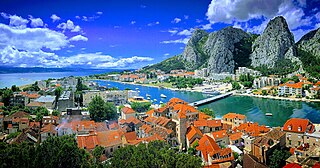
Omiš is a town and port in the Dalmatia region of Croatia, and a municipality in the Split-Dalmatia County. The town is approximately 25 kilometres south-east of Croatia's second largest city, Split, where the Cetina River meets the Adriatic Sea. Omiš municipality has a population of 14,936 and its area is 266 square kilometres (103 sq mi).

The Krka Monastery is a Serbian Orthodox monastery dedicated to the Archangel Michael, located near the river Krka, 3 kilometres (1.9 mi) east of Kistanje, in central Dalmatia, Croatia. It is the best known monastery of the Serbian Orthodox Church in Croatia and it is officially protected as part of the Krka National Park. It was established around 1577 or later on the ground of previous Gothic-Romanesque style Catholic church.
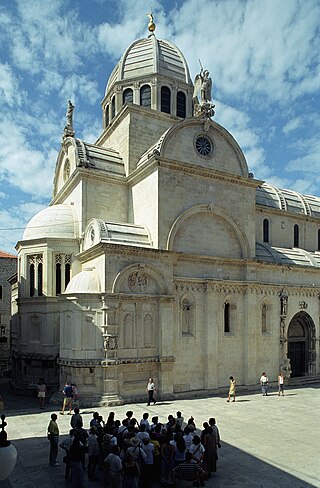
The architecture of Croatia has roots in a long history: the Croats have inhabited the area for fourteen centuries, but there are important remnants of earlier periods still preserved in the country. The historic architecture of most old towns on the coast is Venetian, a legacy of the Venetian empire. The Habsburg and Ottoman empires also influenced the architecture of the region.
Croatian art describes the visual arts in Croatia, and art by Croatian artists from prehistoric times to the present. In Early Middle Ages, Croatia was an important centre for art and architecture in south eastern Europe. There were many Croatian artists during the Medieval period, and the arts flourished during the Renaissance. Later styles in Croatia included Baroque and Rococo.

Nicholas Tavelic, OFM was a Croatian Franciscan friar and missionary who died a martyr's death in Jerusalem on November 14, 1391. He was beatified with his companions, who included friars from Italy and France. All four members of his group have been declared saints by the Catholic Church, making Tavelic the first canonized Croatian saint.

The Crown of Zvonimir was bestowed on King Demetrius Zvonimir of Croatia in 1075 by the papal legate of Pope Gregory VII at Basilica of Saint Peter and Moses at Salona.

The Church of St. Donatus is a Catholic church located in Zadar, Croatia. Its name refers to Donatus of Zadar, who began construction on this church in the 9th century and ended it on the northeastern part of the Roman forum.
Maovice is a small village in Split-Dalmatia county, Croatia. Maovice is a settlement in the Vrlika municipality, and has a population of 494. The majority of the population are Croats.

The Church of the Holy Salvation or Holy Saviour was a Pre-Romanesque church in the Dalmatian Hinterland, Croatia, whose ruins are now a historic site. It is located in the small village of Cetina, near the spring of the river Cetina, 8 km northwest from the town of Vrlika.
Cetina is a small village, administratively located in the Civljane Municipality in Šibenik-Knin County, Croatia. According to the 2011 census, the village had 195 inhabitants.
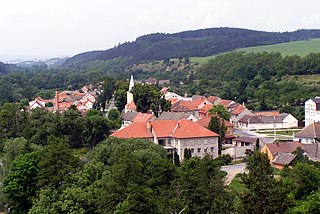
Vladislav is a market town in Třebíč District in the Vysočina Region of the Czech Republic. It has about 1,200 inhabitants.

Hollow Church is the archaeological excavation of what used to be a Romanesque Roman Catholic church in the 11th-century Salona, Croatia.

Bribir is a village in Šibenik-Knin County, near the town of Skradin, in southern Croatia. In its location in the Roman period was town Varvaria, while during the medieval times it was an important and rich settlement with a stronghold and Franciscan monastery, a capital city of power of the Šubić family.

Croatian Pre-Romanesque art and architecture or Old Croatian Art is Pre-Romanesque art and architecture of Croats from their arrival at Balkans till the end of the 11th century when begins the dominance of Romanesque style in art; that was the time of Croatian rulers.

Church of St. Catherine is a Baroque-style church in Zagreb.
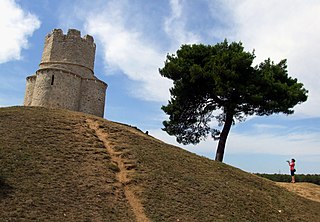
The Church of St. Nicholas is a late 11th or early 12th century Pre-Romanesque style Roman Catholic church located in the field of Prahulje, one mile from Zadar, between Zaton and Nin in Croatia. It was built on the earthen pyramid mound on top of the Liburnian prehistoric tomb.
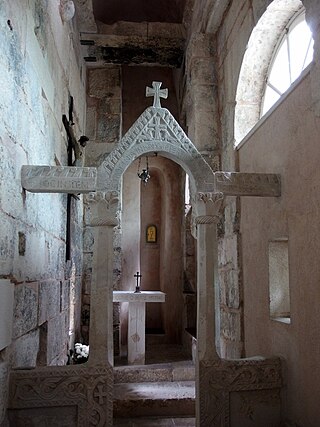
St. Martin's Church is a Roman Catholic church in Split, Croatia. Built into a small space within the ancient Golden Gate of Diocletian's northern wall, it is one of the oldest churches in the city. St. Martin's Church is one of Split's tourist attractions and is known for its fine 11th century chancel screen. It is currently in the care of the Dominican sisters, who have a monastery next door. The church itself is open to public visits.

















